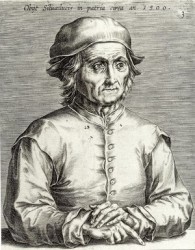
Justi 1889
“Die Werke des Hieronymus Bosch in Spanien” (Carl Justi) 1889
[in: Jahrbuch der königlichen Preuszischen Kunstsammlungen, X (1889), pp. 121-144]
[Also mentioned in Gibson 1983: 165 (H39)]
Little is known about Bosch’s life. The most important document concerning his personality is his oeuvre. From his way of painting could be derived that he spent his youth in Brussels or Antwerp. His works were widely spread. Seldomly they are lacking in the collections of the contemporary royal art lovers, also in the roman countries. His greatest admirer was Don Felipe de Guevara, his greatest collector Philip II. Many works from Philip’s collections have been lost, though, partially due to fires and because of the fact that they were painted on canvas.
Justi divides the works of Bosch into three groups: the religious histories, the proverbs and genre paintings, and the ‘dreams’. Under the caption ‘religious histories’ he discusses the Carrying of the Cross (nowadays in the Escorial in Spain), the Crowning with Thorns in the Escorial and a similar work in Valencia, the Adoration of the Child (Cologne) and the Adoration of the Magi (Madrid, Prado). The proverbs and genre paintings (Sittenbilder) were mostly painted on canvas. No original has been found up to now (= 1889). The Cutting of the Stone (Madrid, Prado) could be an original. In this genre Bosch is the precursor of Bruegel, Aertsen, Beukelaer and partially also of Quinten Metsys and Lucas van Leyden.
The allegorical and satirical paintings, in which Bosch is genuinely medieval, are brought together under the heading ‘dreams’. It are the Seven Deadly Sins (tabletop, Prado), the Haywain (Prado and Escorial), the Lust der Welt (= Garden of Delights, Prado) and the Temptations of St. Anthony (today in Lisbon, back then still in the Ayuda Castle). They are all variations on the issue of Evil, the wings showing its origin and end, the central panels the struggle. Bosch’s monsters get their comical and artistic value from the fact that they are very true to nature in all their parts, but the way in which these parts are brought together is unique.
Because a large number of Bosch’s works have been in Spain for centuries, his oeuvre has known a fruitful reception there. In Spain Bosch had both advocates and adversaries: some thought he was a heretic (Francisco de Quevedo, Pacheco), others defended his orthodox Christian opinions (Fray José de Siguenza, Fray Francisco de los Santos, Andres Ximenes). Some even thought he was a Spaniard (Jusepe Martinez). Bosch was a religious moralist, a Lent preacher in a layman’s habit and a kindred spirit of Brant, Murner and Geiler von Kaisersperg. New about Bosch was that he introduced the achievements of masonry and sculpture in the panel painting of the Eyckian school, where sheer sobriety was the rule. Bosch’s devilries have to be associated with the belief in witches (Malleus Maleficarum).
Twice Justi stresses that the dreamer Bosch was in the first place a painter, und zwar sehr ein Maler [pp. 124/141]. Bosch possessed enough self-control to restrain his comical phantasy when it was necessary. Yet Justi deplores the fact that Bosch did not stick to the ordinary more often. His ‘dreams’ could be called ‘the devil’s album’. In an appendix Justi offers numerous extracts from sixteenth- and seventeenth-century inventories.
[explicit]